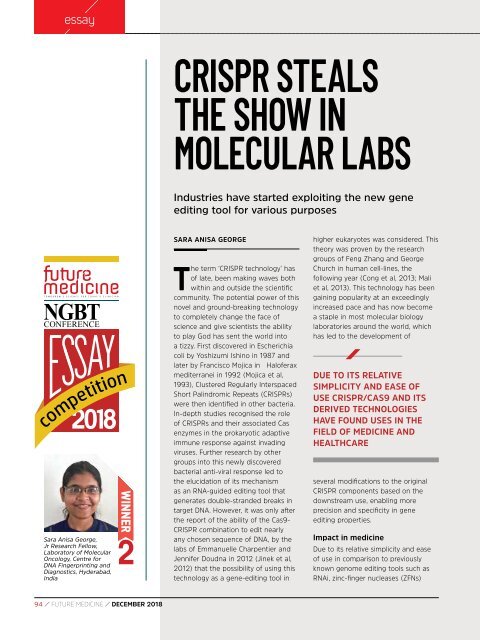FM DECEMBER 2018 ISSUE - digital edition
Create successful ePaper yourself
Turn your PDF publications into a flip-book with our unique Google optimized e-Paper software.
essay<br />
CRISPR STEALS<br />
THE SHOW IN<br />
MOLECULAR LABS<br />
Industries have started exploiting the new gene<br />
editing tool for various purposes<br />
CONFERENCE<br />
<strong>2018</strong><br />
competition<br />
Sara Anisa George,<br />
Jr Research Fellow,<br />
Laboratory of Molecular<br />
Oncology, Centre for<br />
DNA Fingerprinting and<br />
Diagnostics, Hyderabad,<br />
India<br />
SARA ANISA GEORGE<br />
The term ‘CRISPR technology’ has<br />
of late, been making waves both<br />
within and outside the scientific<br />
community. The potential power of this<br />
novel and ground-breaking technology<br />
to completely change the face of<br />
science and give scientists the ability<br />
to play God has sent the world into<br />
a tizzy. First discovered in Escherichia<br />
coli by Yoshizumi Ishino in 1987 and<br />
later by Francisco Mojica in Haloferax<br />
mediterranei in 1992 (Mojica et al,<br />
1993), Clustered Regularly Interspaced<br />
Short Palindromic Repeats (CRISPRs)<br />
were then identified in other bacteria.<br />
In-depth studies recognised the role<br />
of CRISPRs and their associated Cas<br />
enzymes in the prokaryotic adaptive<br />
immune response against invading<br />
viruses. Further research by other<br />
groups into this newly discovered<br />
bacterial anti-viral response led to<br />
the elucidation of its mechanism<br />
as an RNA-guided editing tool that<br />
generates double-stranded breaks in<br />
target DNA. However, it was only after<br />
the report of the ability of the Cas9-<br />
CRISPR combination to edit nearly<br />
any chosen sequence of DNA, by the<br />
labs of Emmanuelle Charpentier and<br />
Jennifer Doudna in 2012 (Jinek et al,<br />
2012) that the possibility of using this<br />
technology as a gene-editing tool in<br />
higher eukaryotes was considered. This<br />
theory was proven by the research<br />
groups of Feng Zhang and George<br />
Church in human cell-lines, the<br />
following year (Cong et al, 2013; Mali<br />
et al, 2013). This technology has been<br />
gaining popularity at an exceedingly<br />
increased pace and has now become<br />
a staple in most molecular biology<br />
laboratories around the world, which<br />
has led to the development of<br />
DUE TO ITS RELATIVE<br />
SIMPLICITY AND EASE OF<br />
USE CRISPR/CAS9 AND ITS<br />
DERIVED TECHNOLOGIES<br />
HAVE FOUND USES IN THE<br />
FIELD OF MEDICINE AND<br />
HEALTHCARE<br />
several modifications to the original<br />
CRISPR components based on the<br />
downstream use, enabling more<br />
precision and specificity in gene<br />
editing properties.<br />
Impact in medicine<br />
Due to its relative simplicity and ease<br />
of use in comparison to previously<br />
known genome editing tools such as<br />
RNAi, zinc-finger nucleases (ZFNs)<br />
94 / FUTURE MEDICINE / <strong>DECEMBER</strong> <strong>2018</strong>


















